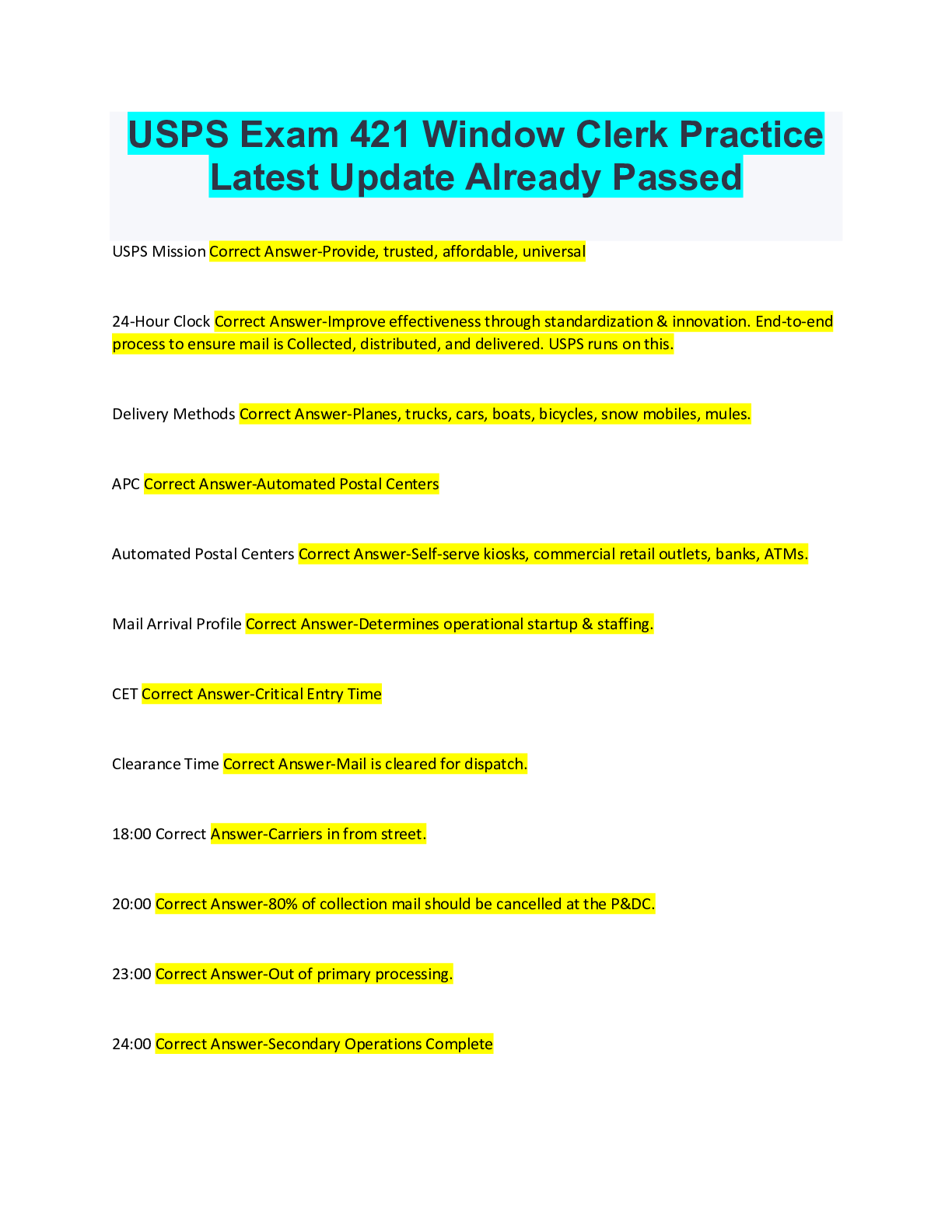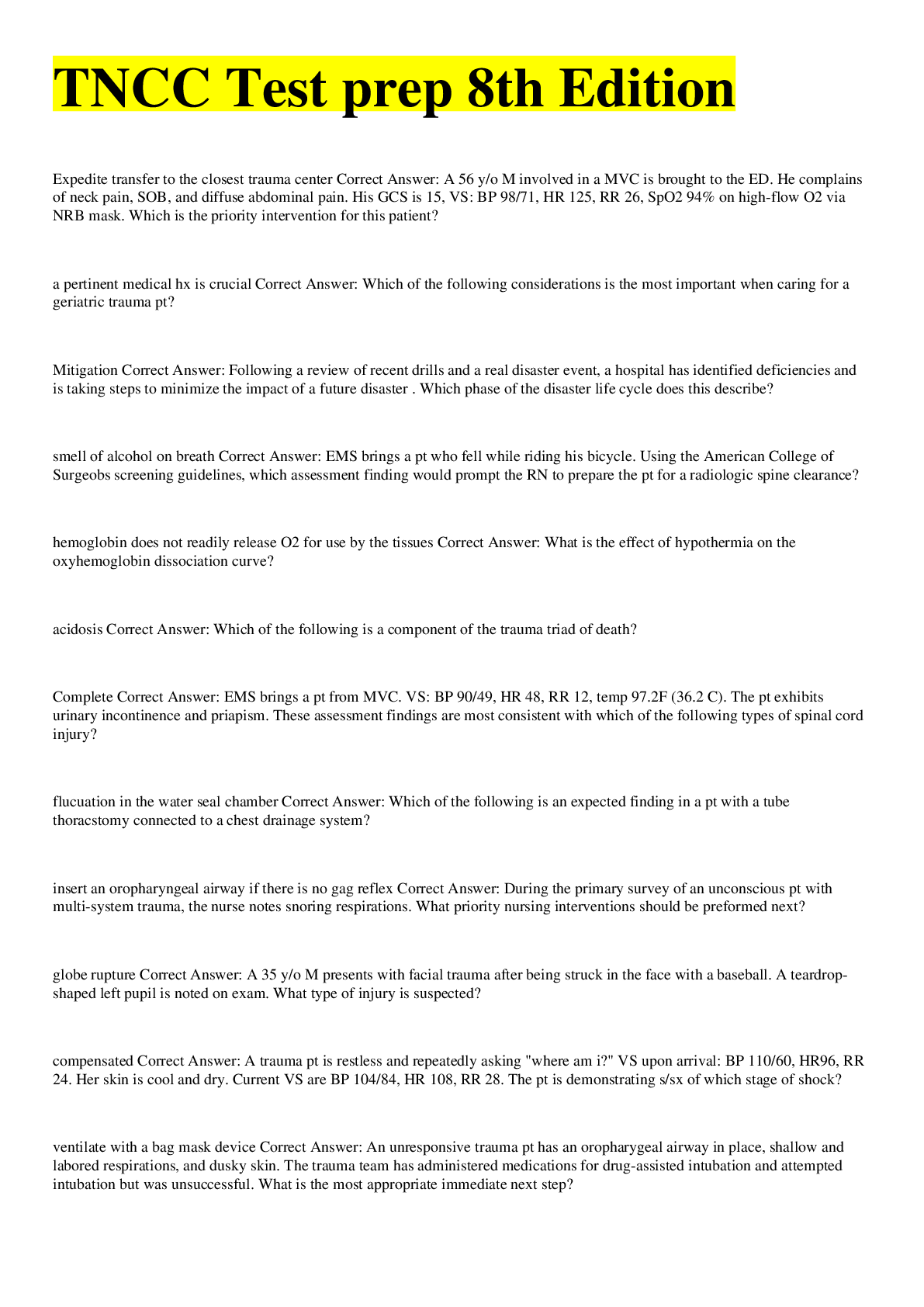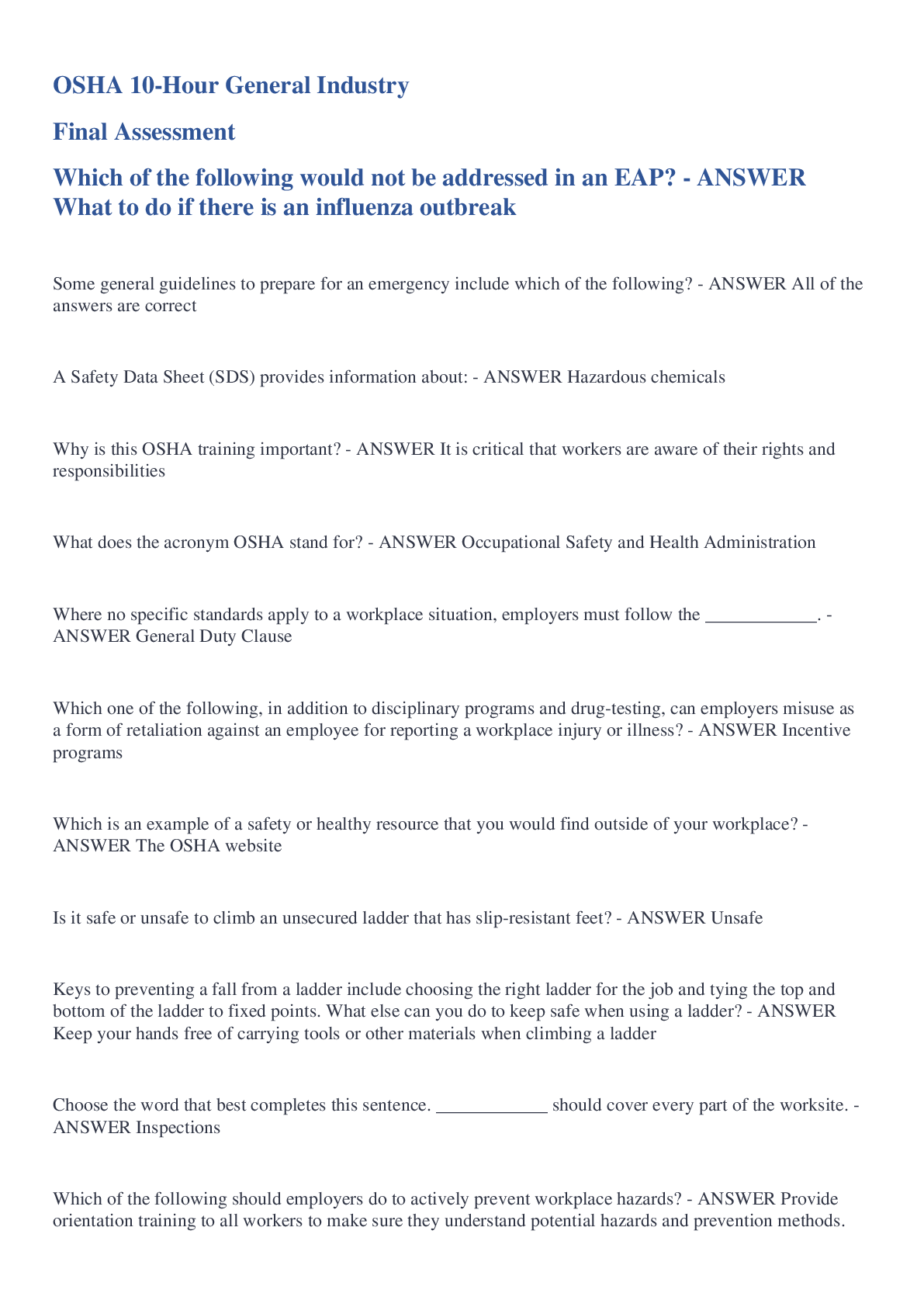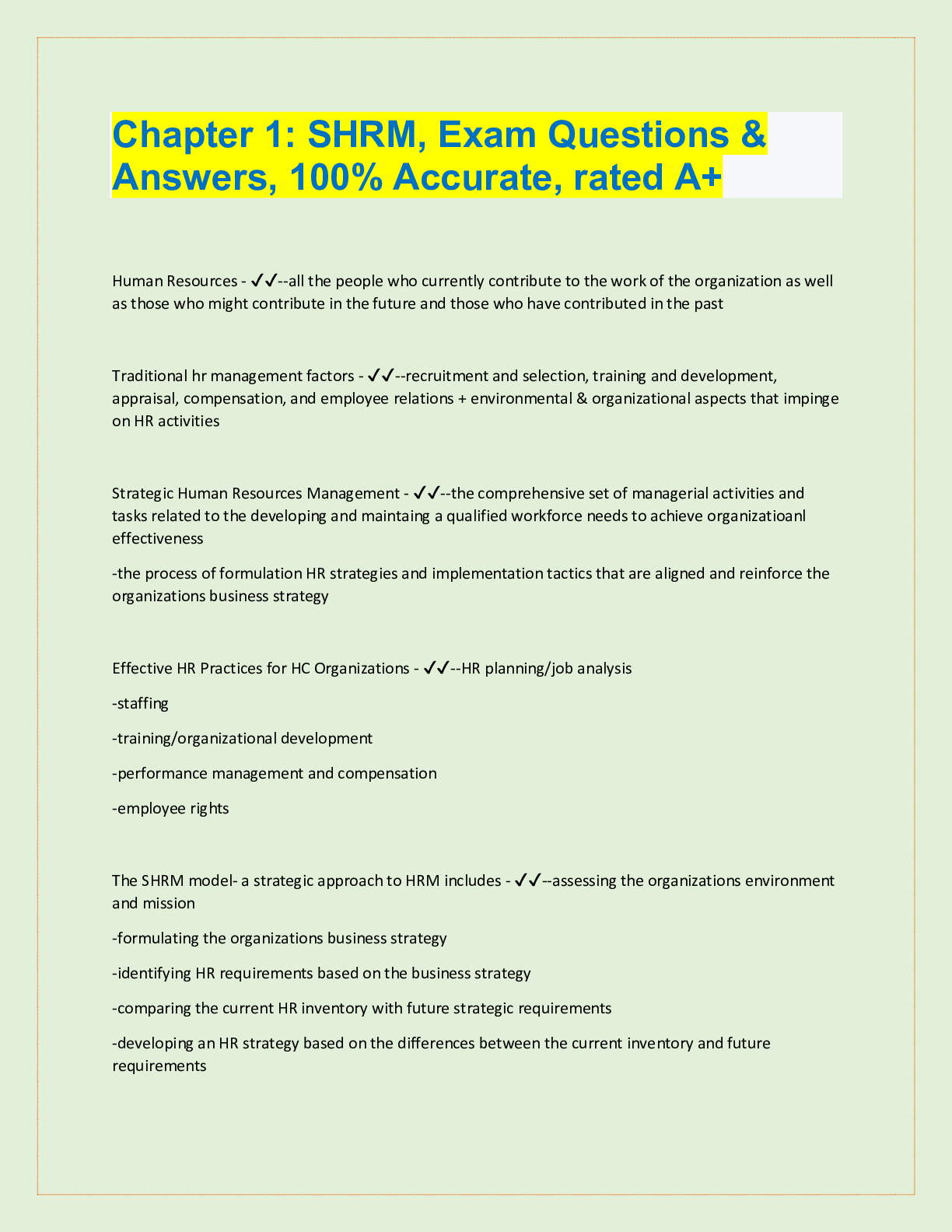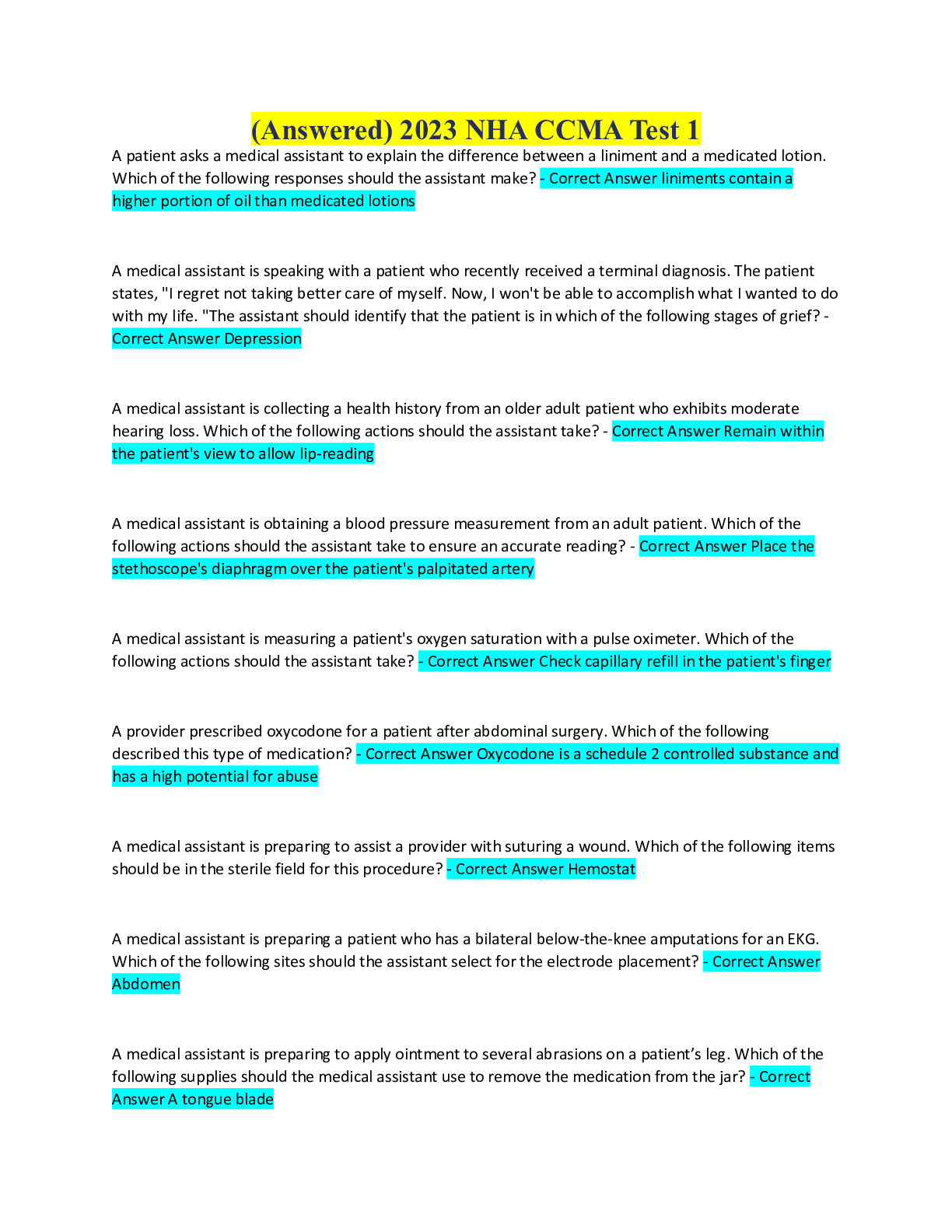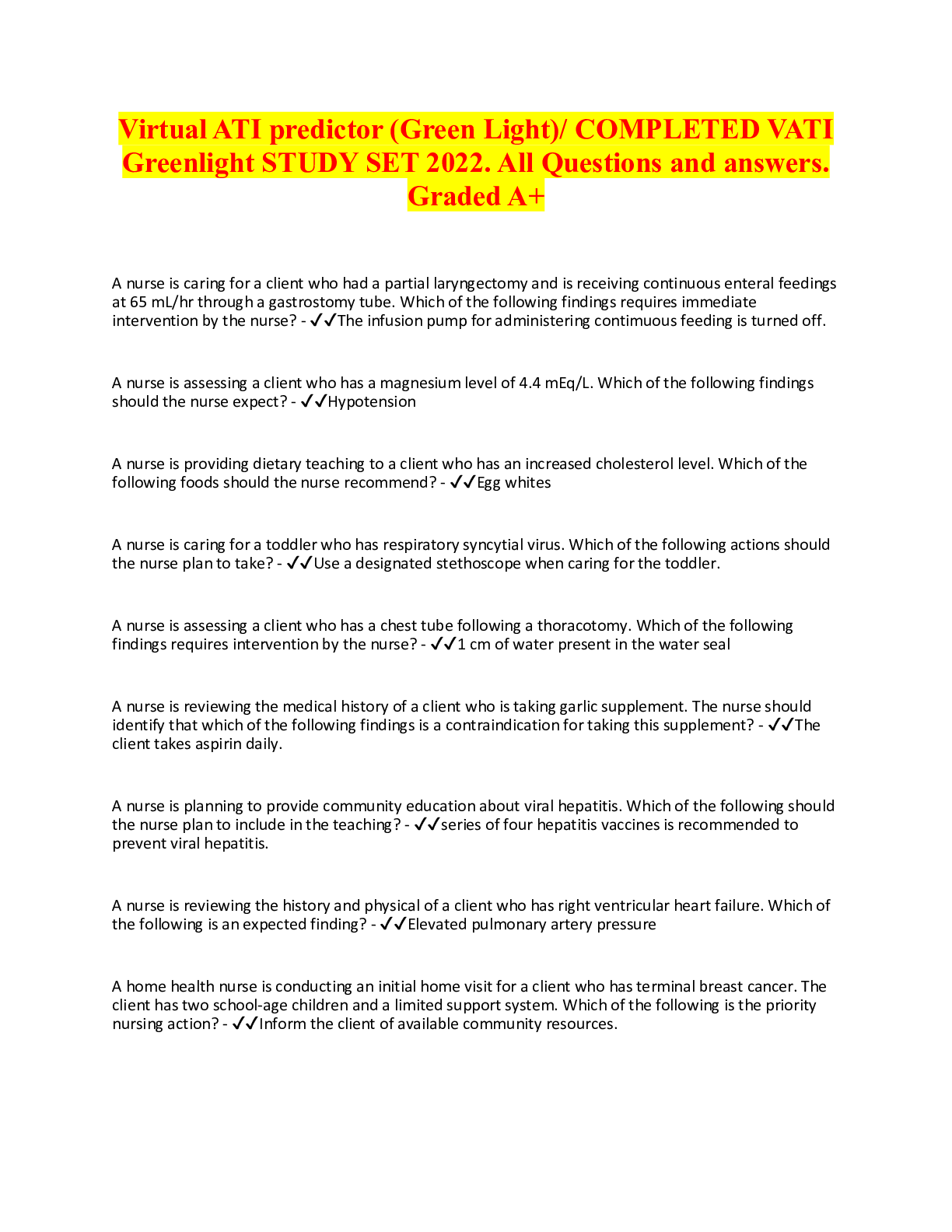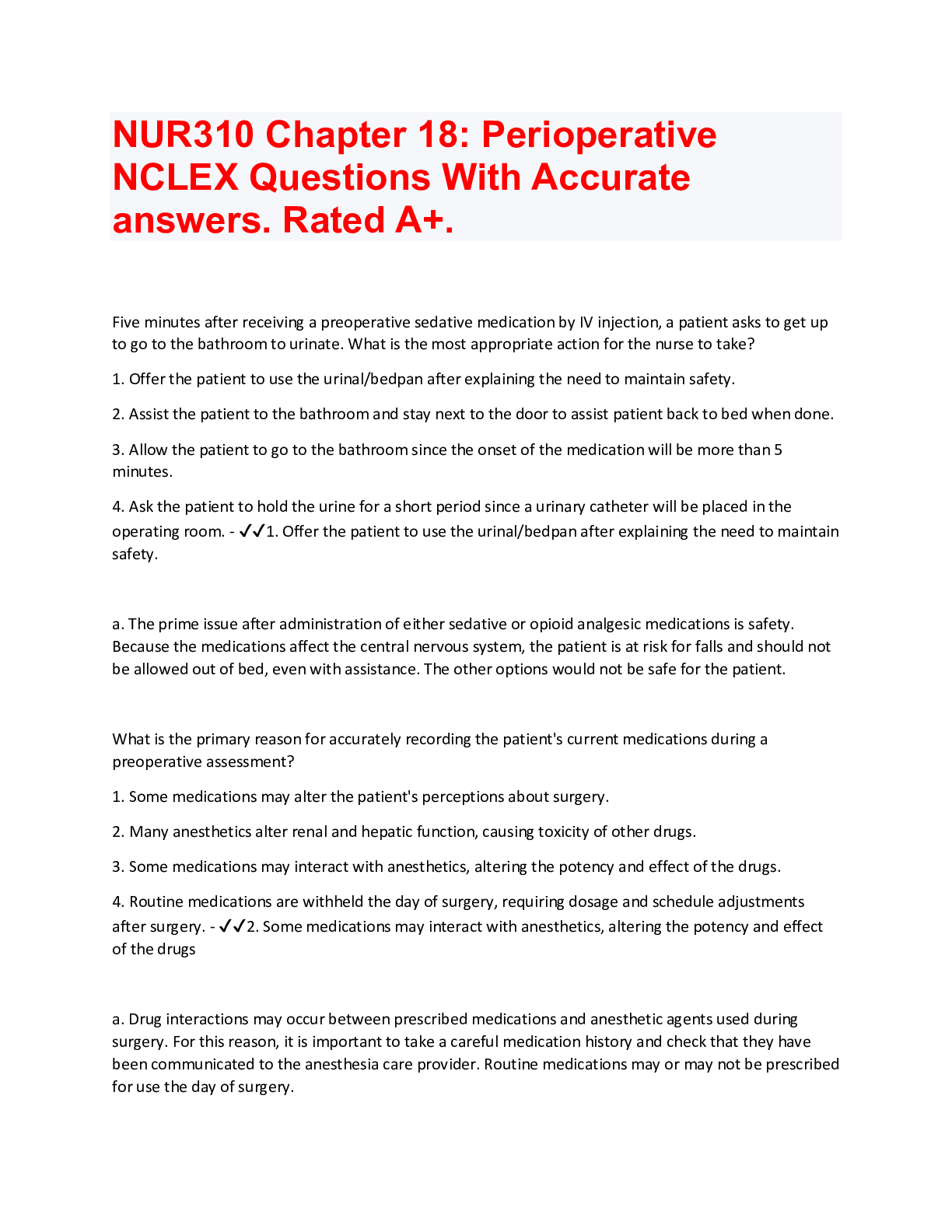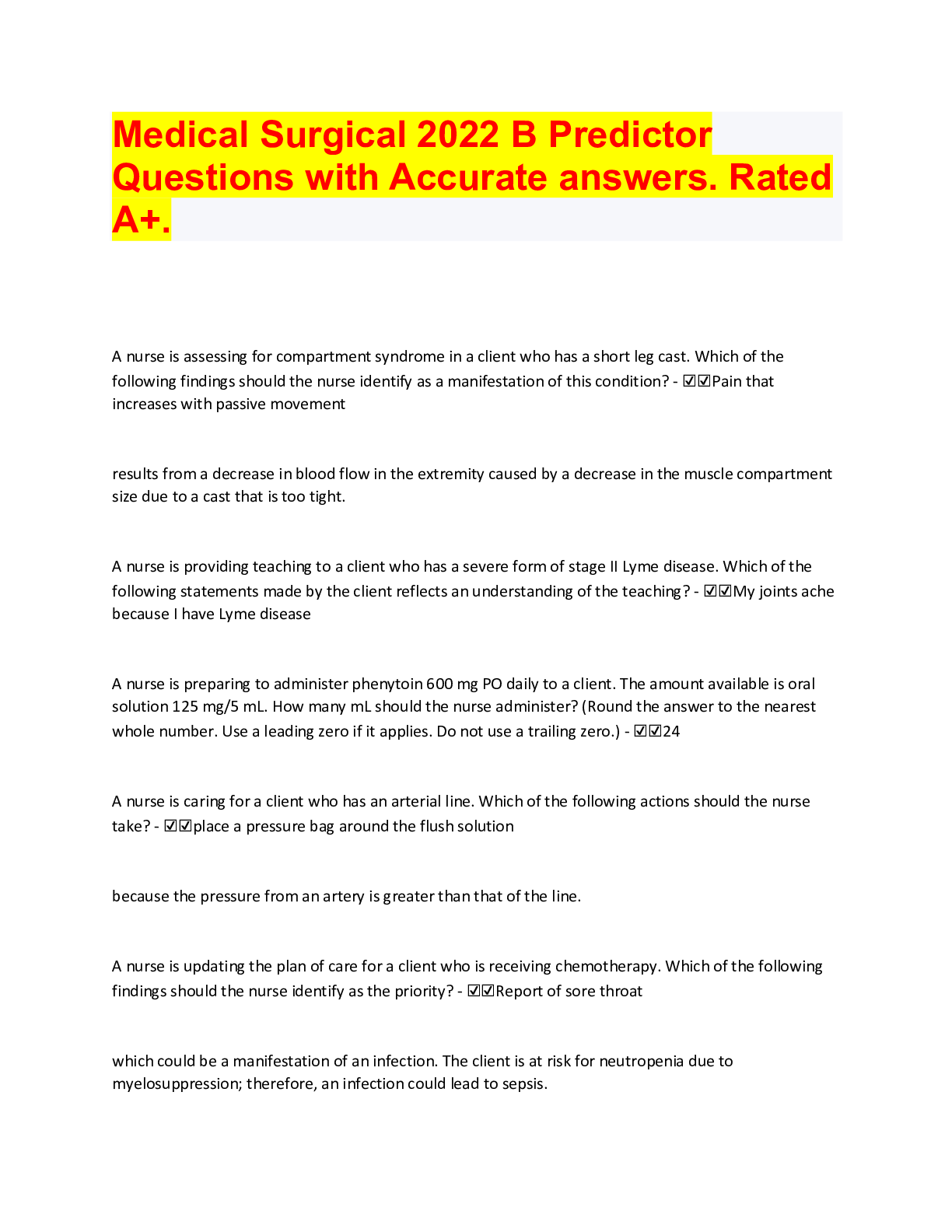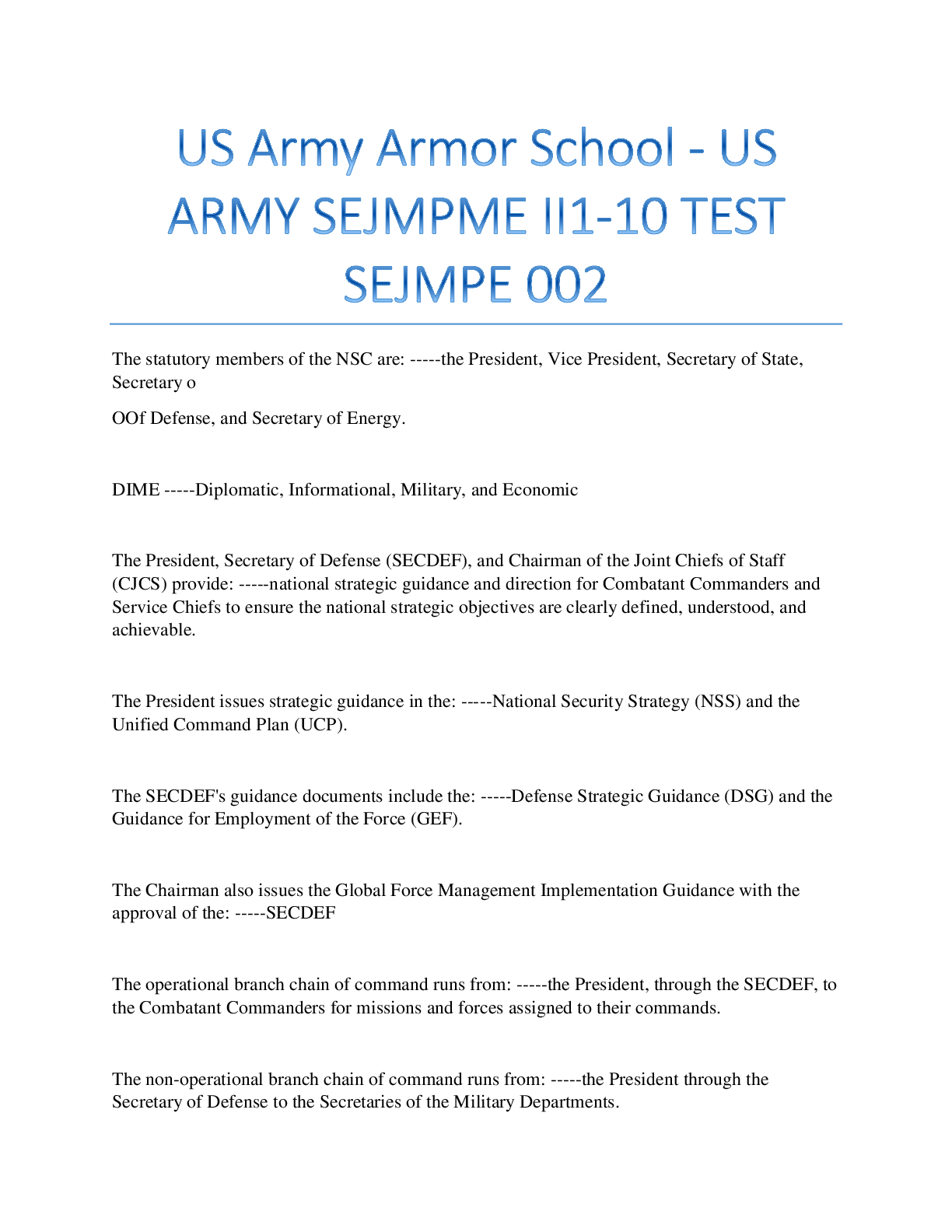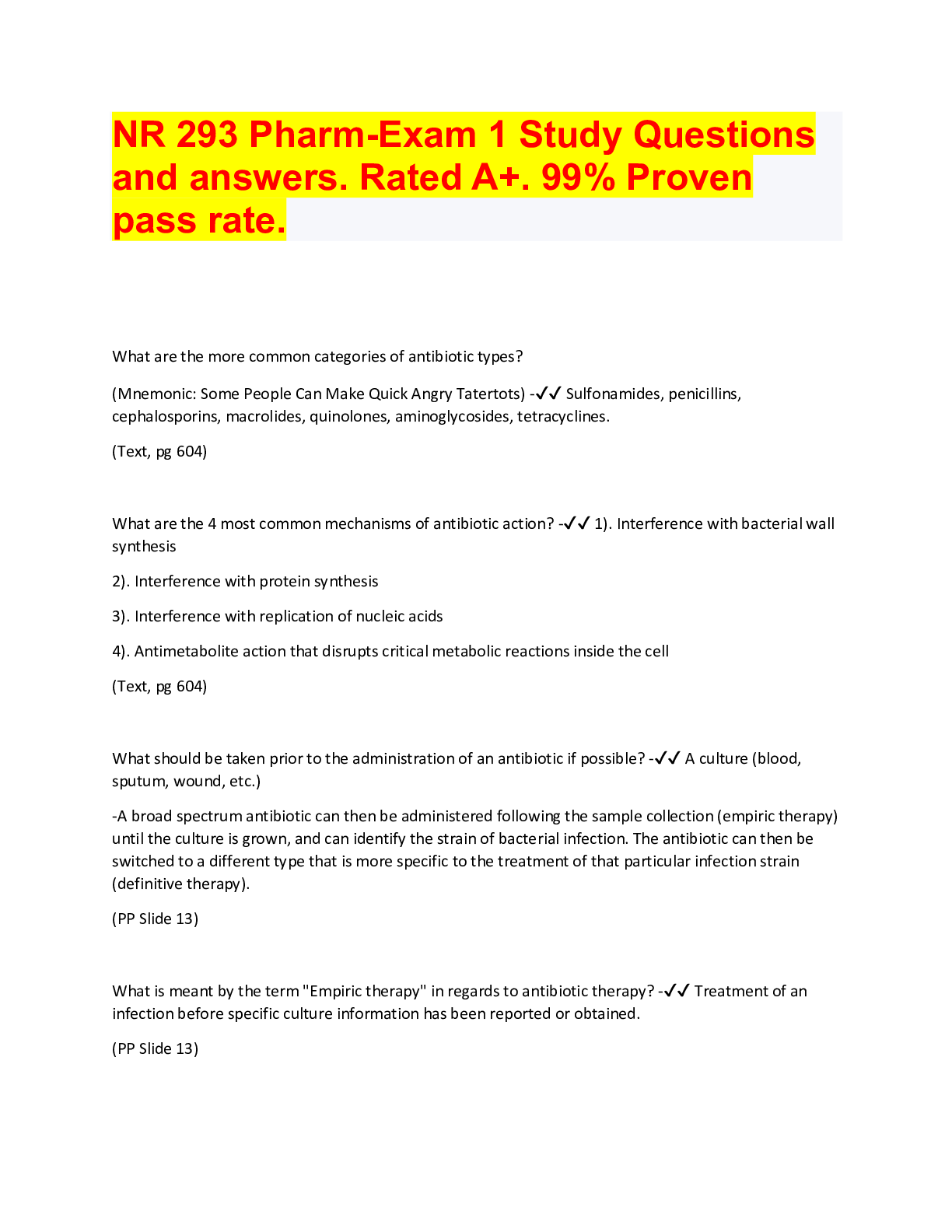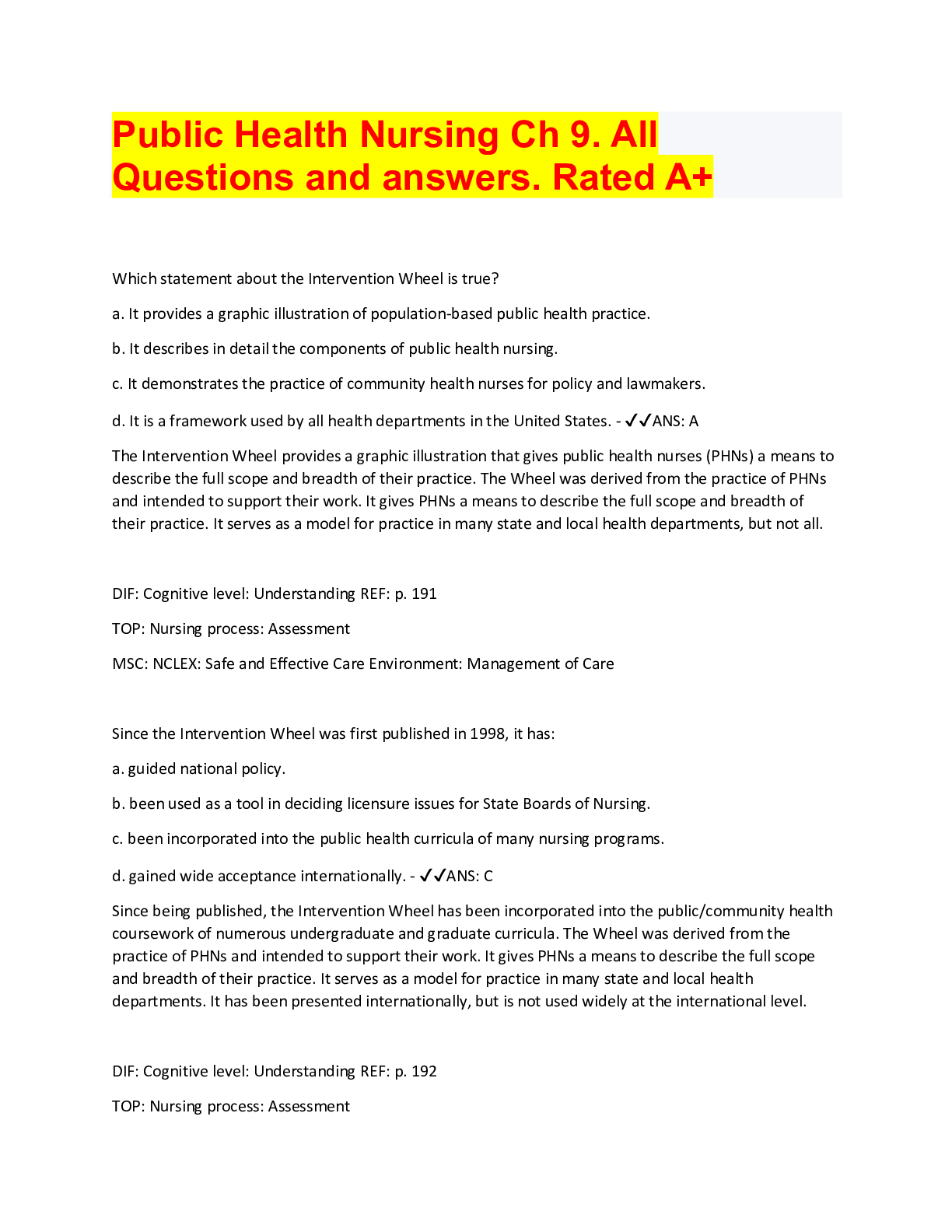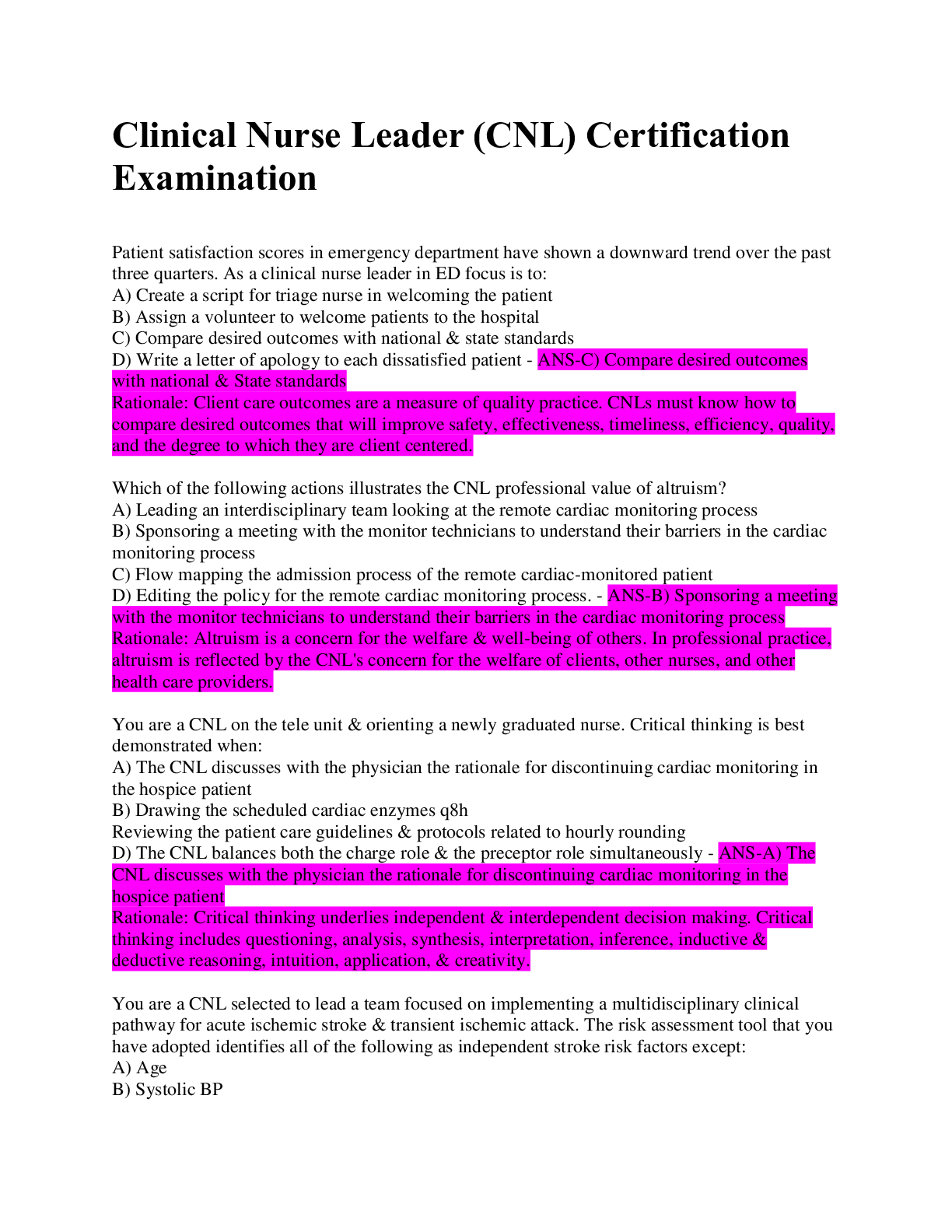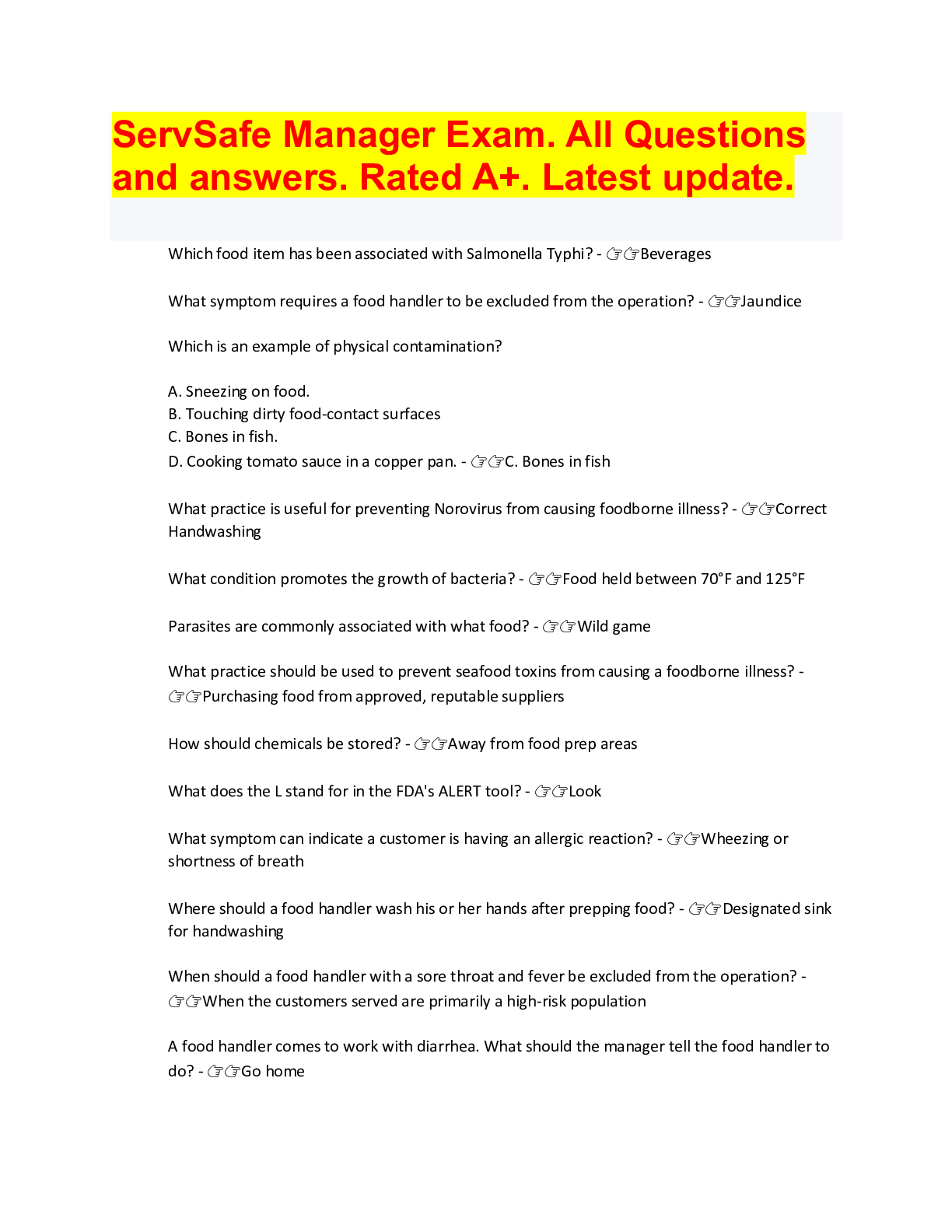Nutrition > QUESTIONS & ANSWERS > Chapter 14: Heart Test Bank—Nursing. All questions and answers. Rated A+. (All)
Chapter 14: Heart Test Bank—Nursing. All questions and answers. Rated A+.
Document Content and Description Below
Which two heart chambers are most anterior in the chest? a. Both atria b. Both ventricles c. The right atrium and ventricle d. The left atrium and ventricle -☑☑ ANS: C The most anterior s... urface of the heart is formed by the right ventricle. The heart is turned ventrally on its axis, putting its right side more forward. The left atrium is above the left ventricle, forming the most posterior aspect of the heart. The condition in which a patient's heart is rotated or displaced to the right or is situated as a mirror image of the expected position is called: a. amyloidosis. b. coarctation. c. dextrocardia. d. situs inversus. -☑☑ ANS: C Dextrocardia occurs when the heart is displaced or rotated to the right or is a complete mirror image of the expected finding. Amyloidosis is a metabolic disorder marked by amyloid deposits in organs and tissues. Coarctation is the compression of the walls of a vessel, such as an aortic coarctation. Situs inversus occurs when the heart and stomach are displaced to the right and the liver is located to the left. Heart position can vary depending on body habitus. In a short stocky individual, you would expect the heart to be located: a. more to the right and hanging more vertically. b. more to the left and lying more horizontally. c. riding higher in the chest and pushed anteriorly. d. hanging lower in the chest and riding more vertically. -☑☑ ANS: B The position of the heart varies depending on body build, configuration of the chest, and level of the diaphragm. A tall slender person's heart tends to hang vertically and is positioned centrally. A stocky short person's heart tends to lie more to the left and more horizontally. Which cardiac structure is responsible for the heart's pumping action? a. Pericardium b. Epicardium c. Myocardium d. Endocardium -☑☑ ANS: C The myocardium is the thick muscular middle layer responsible for the pumping action of the heart. The pericardium is the tough, double-walled, fibrous sac that protects the heart. The epicardium is the thin outermost muscle layer that covers the heart and extends onto the great vessels. The endocardium is the innermost layer that lines the chambers of the heart and covers heart valves. Contraction of the ventricles causes: a. closure of the atrioventricular valves. b. closure of the pulmonic and aortic valves. c. opening of the auricular septa. d. opening of the mitral and tricuspid valves. -☑☑ ANS: A When the ventricles contract the semilunar valves, the pulmonic and aortic valves open, causing blood to rush into the pulmonary artery and the aorta. At this time, the tricuspid and mitral valves close, preventing backflow into the atria. When the atria contract, the tricuspid and mitral valves open, allowing blood flow into the ventricles. When the ventricles relax during diastole (ventricles are filling), the aortic and pulmonic valves close, preventing backflow into the ventricles. Which two structures together form the primary muscle mass of the heart? a. Right and left ventricles b. Left ventricle and the aorta c. Right and left atria d. Left atrium and the pulmonary vein -☑☑ ANS: A The ventricles are large, thick-walled chambers that pump blood to the lungs and throughout the body. The right and left ventricles together form the primary muscle mass of the heart. The left ventricle pumps blood through the aortic valve into the aorta, which provides blood to the rest of the body. The right and left atria pump blood through the tricuspid and mitral valves to the ventricles. The pulmonary vein pumps oxygenated blood from the lungs to the left atria. The major heart sounds are normally created by: a. valves opening. b. valves closing. c. the rapid movement of blood. d. rubbing together of the cardiac walls -☑☑ ANS: B At the beginning of systole, ventricular contraction raises the pressure in the ventricles and forces the mitral and tricuspid valves closed, which produces the first heart sound S1, "lub." When the pressure in the ventricles falls, below that of the aorta and pulmonary artery, and when the ventricles are almost empty, the aortic and pulmonic valves close, producing the second heart sound S2, "dub." Valve opening is usually a silent event. Ms. Sharpe is a 22-year-old secretary. She presents with fatigue, malaise, and a rash. On auscultation of her heart, you note murmurs of mitral regurgitation and aortic stenosis. She reports a recent severe sore throat. You suspect: a. angina. b. acute rheumatic fever. c. cardiac amyloidosis. d. aortic sclerosis. -☑☑ ANS: B Acute rheumatic fever is a systemic connective tissue disease that occurs after a streptococcal pharyngitis or skin infection. It may result in serious cardiac valvular involvement of the mitral or aortic valve. Often, the valve becomes stenotic and regurgitant. Prevention is adequate treatment of the streptococcal pharyngitis or skin infection. A grade IV mitral regurgitation murmur would: a. be described as a diastolic murmur. b. not be expected to have a thrill. c. radiate to the axilla. d. be heard best at the base. -☑☑ ANS: C A grade IV murmur would have a thrill; a mitral regurgitation murmur is best heard at the apex, is holosystolic, and would radiate to the axilla. Electrical activity recorded by the electrocardiogram (ECG) tracing that denotes the spread of the stimulus through the atria is the: a. P wave. b. PR interval. c. QRS complex. d. ST segment. -☑☑ ANS: A The P wave represents the spread of a stimulus through the atria (atrial depolarization). The PR interval is the time from the initial stimulation of the atria to the initial stimulation of the ventricles, usually 0.12 to 0.20 second. The QRS complex is the spread of a stimulus through the ventricles (ventricular depolarization), less than 0.10 second. The ST segment and T wave are the return of stimulated ventricular muscle to a resting state (ventricular repolarization). The pacing structure of the heart's electrical activity is the: a. AV node. b. bundle of His. c. Purkinje fibers. d. sinoatrial (SA) node -☑☑ ANS: D An electrical impulse stimulates each myocardial contraction; this impulse originates in and is paced by the SA node. Purkinje fibers are located in the: a. sinoatrial node. b. atrioventricular node. c. myocardium. d. aortic arch. -☑☑ ANS: C The Purkinje fibers are located in the ventricular myocardium. The spread of the impulse through the ventricles (ventricular depolarization) is depicted on the ECG as the: a. P wave. b. QRS complex. c. PR interval. d. T wave. -☑☑ ANS: B The QRS complex is the spread of a stimulus through the ventricles and is measured as less than 0.10 second. The P wave is the spread of a stimulus through the atria. The PR interval is the time from the initial stimulation of the atria to the initiation of stimulation of the ventricles. The T wave is the return of stimulated ventricular muscle to a resting state. In the fetus, the right ventricle pumps blood through the: a. left atrium. b. ductus arteriosus. c. lungs. d. foramen ovale. -☑☑ ANS: B The right ventricle of a fetal heart pumps blood through the patent ductus arteriosus rather than into the lungs, not through the left atrium, lungs, or foramen ovale. In what age group are the right and left ventricles equal in weight and muscle mass? a. Newborns b. School-age children c. Adolescents d. Older adults -☑☑ ANS: A At the time of birth, the right and left ventricles are equal in weight and muscle mass because they both pump blood into the systemic circulation. Within 24 to 48 hours, closure of the ductus arteriosus and interatrial foramen ovale causes pressure in the left atrium to increase. At this time, the right ventricles demand changes as the pulmonary circulation develops, and the left ventricle assumes total responsibility for providing systemic circulation. This results in an increase in the mass of the left ventricle. In older adults, the left ventricle wall thickens and the valves become fibrotic and calcified. The right and left ventricles are not equal in weight and muscle mass in school-age children, adolescents, or older adults. Closure of the ductus arteriosus usually occurs: a. 24 to 48 hours after birth. b. after 7 days of life. c. between the second and third month. d. during the toddler period. -☑☑ ANS: A Closure of the ductus arteriosus usually occurs within 24 to 48 hours after birth. The apex of a 2-month-old baby's heart typically lies closest to the: a. fourth left intercostal space. b. midsternal area. c. midthoracic spinal area. d. sixth left intercostal space. -☑☑ ANS: A In infants and young children, the heart lies more horizontally in the chest. The apex of the heart is located higher, sometimes well out into the fourth left intercostal space. Normal cardiac changes that occur during pregnancy include: a. decreased cardiac output. b. increased thickness and mass of the left ventricle. c. decreased heart rate. d. dilation of the ventricles. -☑☑ ANS: B The maternal blood volume increases by 40% to 50% because of an increase in plasma volume. The heart works harder to accommodate the increased heart rate and stroke volume (both equal cardiac output), thereby resulting in the increase in left ventricle wall thickness and mass. The blood volume returns to prepregnancy levels within 3 to 4 weeks after delivery. As the uterus enlarges and the diaphragm moves upward, the heart is shifted horizontally and there is a slight axis rotation. Which ECG change would not be expected as an age-related pattern? a. First-degree block b. Bundle branch block c. Left ventricular hypertrophy d. Ventricular fibrillation -☑☑ ANS: D Common ECG changes in older adults include first-degree atrioventricular block, bundle branch blocks, ST-T wave abnormalities, premature systole (atrial and ventricular), left anterior hemiblock, left ventricular hypertrophy, and atrial fibrillation. Mr. O, age 50 years, comes for his annual health assessment, which is provided by his employer. During your initial history-taking interview, Mr. O mentions that he routinely engages in light exercise. At this time, you should: a. ask if he makes his own bed daily. b. have the patient describe his exercise. c. make a note that he walks each day. d. record "light exercise" in the history. -☑☑ ANS: B When Mr. O says that he engages in light exercise, have him describe his exercise. To qualify his use of the term light, ask him the type, length of time, frequency, and intensity of his activities. Pleural pain differs from chest discomfort caused by other conditions in that it is: a. precipitated by coughing. b. eased with deep breathing. c. usually described as dull in nature. d. related to time of day. -☑☑ ANS: A Pleural pain is precipitated by breathing and coughing and is usually described as a sharp pain that is present during respirations and absent during breath-holding. Which of the following information belongs in the past medical history section related to heart and blood vessel assessment? a. Adolescent inguinal hernia b. Childhood mumps [Show More]
Last updated: 1 year ago
Preview 1 out of 17 pages
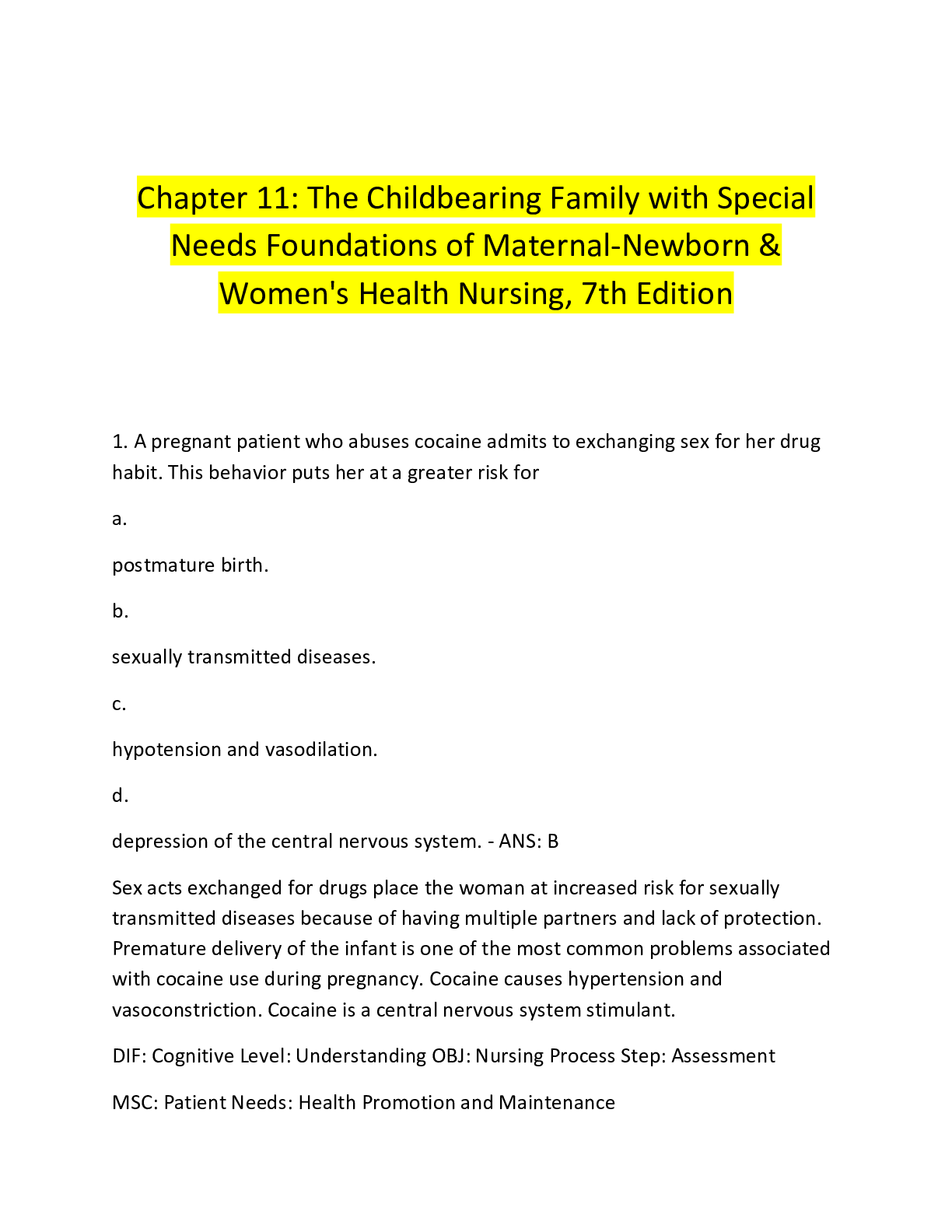
Reviews( 0 )
Document information
Connected school, study & course
About the document
Uploaded On
Aug 08, 2022
Number of pages
17
Written in
Additional information
This document has been written for:
Uploaded
Aug 08, 2022
Downloads
0
Views
63














